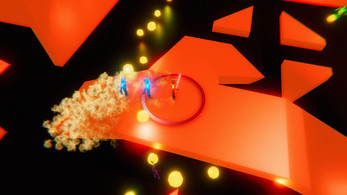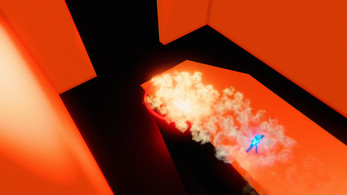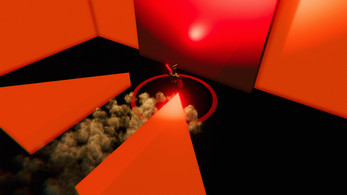
Neo Nylo: Into The Lick
If you can't seem to hit the notes at the right time please try downloading the zip file below (bottom of the page); while it is not easy, it shouldn't be too hard for the regular person. The web version isn't too reliable on inputs and timings, the downloaded version will really improve the experience.
# # # # # # # # # # # # # # # # # # # # # # # # # # # # # # # # # # # # ## # # # # # # # # # # # # # # # # # # # # # # # # #
Controls: Left click to move Neo there. 1-7 in the numerical row to play notes. Play the lick [2 3 4 5 3 x 1 2] to deal radial damage. (x is silence, timing of each number/symbol is in 8th notes at 140bpm)
If you're interested in the process of making the game, read below <3
This game was developed solo as my first jam. Made on Unity 2019.2, used Blender 2.8, GIMP 2.10.8, MuseScore 3, AmpliTube 4 and Audacity 2.3.2 (just to be clear, I'm not working with/for them, that's just the tools I used if anyone is curious). Designed, developed, published and submitted within the 48 hour time limit for the GMTK 2019 Game Jam, with the topic being: 'Only One'
:)
Only One...
The way I got into the idea of the game was, oddly enough, by starting to shift the letters of the phrase "only one". I ended up with the words Nylo and Neo, respectively. Nylo instantly rang a bell: nylon, as in the guitar strings! That silly way of getting ideas, led into making a guitar/bass player that the only thing that they can play is a single note, or melody, or something. I chose the melody, because I felt like the note would just be a substitution for a button, and play with only one button is something I kind of expect seeing a lot of in the submissions. Originally I was thinking about having a narrative about them being selfish and full of themselves, where they are -in their eyes- the only one, however I scrapped the idea due to the time limit, and just went for something more symbolical and arguably cheesy for the ending with nearly no explanation whatsoever.
In short, the premise is simple (though not necessarily easy) enough: make a game based around only one short melody, that is only one measure long. Use that as the only means to defend yourself and attack, while attempting to make it fun. Aditionally, I made it so that you have only one life (you need to start all over if you lose), coded it so that you can play only one note at a time, designed it so that you can move with only one click, and put the entire game (the actual gameplay bits, not counting the introduction) in only one level, so that backtracking can have some interesting ramifications on gameplay, seeing as some enemies chase you (although one could argue that the rooms are just levels without loading required).
The gameplay
Alright, I knew what was going to be the -only one- part mechanically. But what about everything else? What convinced me in the end to join the jam was a nostalgia trip that I had, without going into much detail, some of the first games I made like seven years ago were some top-down shooters and I thought, heck why not, it's my first jam after all. But I didn't want to leave it just at that, I decided that I wanted to make something that was more chaos encouraging. That's where the radial proximity damage idea came from. It is well known that given the chance, players will optimize the fun out of a game, so I decided to make the only way of playing be risky and agressive. By coordinating the lick and moving with mouse clicks (to engage and run away from the enemy), I made sure that you will never feel in complete control (unless you get crazy good at it) and find yourself often in moments where you had to chose fight or flight, and either it paid off or it didn't. The enemies reinforced this, by making fragging the way to progress and by having the turrets shoot at you while you need to get close to them, as chasers and patrollers(?) are getting in your way.
The musical test of fire
Going back to my self-set objective of having only one small melody and turning it into the entire game's music arrangement, there is still one burning question I have that only you, dear player, can answer. Did I manage to make you enjoy repeat a single measure, four beat, lick? I playing the game myself honestly kinda liked it but felt that it was a bit tedious at times, and when it was I adjusted stuff. So experimentally I don't know. Theoretically, I know even less, because in one side: repetition legitimizes, but on the other side: music usually needs variation and contrast right? I think that what I'm making here, is not a piece of music meant to be listened back to, but rather one that is meant to be lived in the moment (sorry if it sounds pretentious or romantic, I went to tryhard and am very sleepy... it was worth it tho). A musical piece which derives directly from gameplay, and gameplay that derives directly from a single musical phrase, creating a piece with a single phrase that maybe is enjoyable(?). Something still tells me that it shouldn't work, but maaybe it will. That's what jams are for right? :)
Some random stuff that I tried and liked and may hopefully help you in the future
- Sometimes not animating stuff and making them look kinda like toys, figures or furniture, is something you can get away with. Am still not convinced if I did though...
-I've always used either player controlled cameras or completely static ones. The middle ground that I used here is actually pretty cool. I felt like a director and used the little knowledge I know about film composing to make it feel good. (Look up Hitchcock and Kuleshov, they're really useful). If you pay close attention, almost all (if not all) of the cameras have you start in the screen's leftmost area, and travel towards the rightmost area. Having enemies going from right to left, being clashing and antagonistic to the player. Also the use of lighting (which admittedly in my game was kind of the bare minimum) to guide a player's attention. The use of objects forming arrows and lines. The different organicness of the shapes in the environment, etc. Composition is really fun and definately improves your game by making it clear, harmonious and implicit.
-Recording historical inputs and comparing them is not as hard as it sounds! (Detecting if you played the lick and if you did it correctly)
-Modular design rules.
-It was really really fun to do this, however I wouldn't push so little hours of sleep again into it. Don't do it, you keep forgetting stuff mid-code and you aren't too productive.
- You will be surprised by what you can do in a short amount of time with enough concentration, you feel like you just teleported in time and stuff simply and automatically got done :)
-Don't fall into the almost finished fallacy, when you're almost finished, you couldn't be farther away from actually finishing. Keep giving it your all, all the way through!
-I still don't totally understand colors :/ ... but blindly following some basic theory and palettes seem to work.
The rooms (spoilers?... I mean, I know it's short and almost story-less, but it is definately worth it to finish the game first!)
I really love level design, it's always so much fun, because you get to teach and show off your game's mechanics. A good level can make almost any mechanic be fun and engaging, while a bad one can make a great mechanic feel subpar.
The first room was designed with old fashioned 1-1 on mind. You begin by finding the player looking towards the door where they should go to as the drums begin. You will then almost instantly see some red thing coming from right to left towards you, and you only know one thing to do; play the lick. The scene is meant to show you where you should go (red doors), who are the bad guys (the demons) and how to fight them right from the bat. Additionally, if you play the lick the moment the second measure begins, you'll get the enemy right on the ring and instantly eliminate them. You are expected to lose and try again in this game, that's why there isn't much problem if you lose: you just go back to the introduction where if you prove you can play the lick twice you'll instantly start the game over and now know what to do. Hopefully, the player can consistently beat every part of the game they've passed by learning from their mistakes and playing consciously. The game isn't too much about can fast you can go, but rather how steadily can you go.
The second room is about teaching you the enemy diversity and how to deal with those new enemies: they can be pretty deadly if you're not cautious enough. The path finding demons will probably throw some people off due to their speed and loopy behaviour, but they will hopefully show the player how to instinctively measure when they should start the lick and where they should be positioned in order to hit a target. In this room, the camera still follows the left to right properties I was talking about before, however it still tells the player where they should go subtly by following the enemies' projectiles and by having the geometry be kinda arrow shaped. In short, the room will test and train the player's timing, kind of like leading a shot on a(n?) FPS wilth bullet physics.
The third room is even more so about patience. This one, alongside the next one, have me a bit worried that they tread too closely to tedium because they can get tough if you're not too patient, and time consuming if you're not aggressive enough in your approach. And oh boy, was I impatient while playtesting the game because I needed to work fast, but when I got the hang of it I felt it pretty easy. I found out that the skills needed to complete the room really ease the rest of the game. If you get this one, chances are you'll finish the game after some few more tries. I think it's some decent primer for what's to come.
For the fourth room what I had in mind was to remove all geometry and make the enemies with their motions be the geometry, carrying the flow and movement of the "scene" almost completely (with help from the camera). It starts off by having a patrol demon seemingly run away from you, leading you toward an ambush of sorts, where you will find multiple chaser demons go towards you and enemy projectiles being fired your way. In this section, the player will be trained to be highly aware of their surroundings while applying everything learned up to this point. It can become a little tedious though, because the patrol demons can be pretty hit or miss with their speed, but they help reinforce the timing and placement concepts from the second room.
For the fifth room, I had two particular concepts in mind to introduce to the player: elevation and the strong chaser enemy (boss? mini-boss?). Firstly, the player will see the ramp (heavily contrasting to the floor, but being at an inviting angle) and when trying to climb it, they will meet the only enemy in that area (and know it due to the highened point of view). It should help to let the player know that this enemy is business. He takes quite some amount of hits, but almost makes up for it in speed. The new demon offers a more consistent threat than the other red chasers that served their purpose as more training/hoarding material. The new elevation, helps to introduce something that will be used on the next room, and is using verticallity as if you were fighting on two fronts simultaneously or as simple run away material. The room, in juxtaposition of the next one, should help to encourage the player to keep moving and to do stuff simultaneously if possible.
Finally, I'll leave the sixth room as a big question mark. All the ingredients of it are layed out on the prior gameplay. I would love to talk a lot about it and how it came to be, but I think it is more valuable that you make your own judgement on it. Please if you haven't, go ahead and beat this challenge, and try to think through why is it the way it is. We humans are pretty terrible at doing random stuff, so pretty much everything hand made/human made, will inevitably not be random and have some (even if flawed or non-rationalized) logic, unless it uses randomness tools or techiques (like dice, coin flips, a computer or pulling out a random item from a mystery box). So remember, act and consume consciously. Why did you make that mechanic that way? Why did you enjoy the game? Why did you hate the game? Why did the director frame the scene the way they did? And so I beg the question to you: How was the sixth room designed? You may never be absolutely correct, but making up some theory and experimenting with it, might just improve your games and teach you something new. Learning to ask these questions and coming up with rational answers, will make your life better. :)
Thanks for reading my random notes and thoughts on my random game. Hope you enjoy it! Had some weirdly busy back to back all nighters working on it, but if it can make a single person happy, it would have been more than worth it. And please, if you would like to: leave suggestions, comments, etc. I'd really like to improve and hear from you, both what I did wrong and should take care of, and what I did right but did not notice. There are quite some things I would change, but time is golden plus I want to hear you out!
Thanks again, if you're reading this or playing the game.
:'D
Download
Install instructions
0. Make sure to choose the right zip file for your OS and have a 64-bit version of it (note that the Linux version is untested because I don't have Linux installed at the moment, but it should work fine) (Use v2 if you're playing the game after the jam)
1. Download the zip file
2. Unzip it (make sure to keep all the files inside the same folder together)
3. Open the newly created folder called Neo Nylo Into The Lick GMTK Jam
4. Inside the folder, double click Neo Nylo GMTK Jam.exe (the extension for Linux should be .x86_64 instead of .exe)
5. Enjoy
If you can't run the game on Linux (Ubuntu)
- Right click the .x86_64 file
- Choose 'Properties'
- Go to the 'Permissions' tab
- Tick 'Allow executing this file as a program'
- Close the dialog.





Leave a comment
Log in with itch.io to leave a comment.